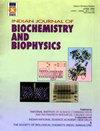Design and development of mutant EGFR inhibitors from a structural perspective
IF 1.5
4区 生物学
Q4 BIOCHEMISTRY & MOLECULAR BIOLOGY
引用次数: 0
Abstract
Molecules targeting non-small cell lung cancer driven by activating mutations within the epidermal growth factor receptor (EGFR) are highly effective but acquired drug resistance remains a persistent challenge. Insights from structural pharmacology and medicinal chemistry have aided in detailed understanding of the structural basis for how these inhibitors gain their mutant EGFR selective inhibitory activity and inform state-of-the-art drug design. The novel third-generation EGFR tyrosine kinase inhibitor (TKI) YH25448 (lazertinib) binds to EGFR with T790M-targeting van der Waals interactions and intramolecular hydrogen bonds consistent with improved medicinal chemistry properties compared to AZD9291 (osimertinib). Additionally, fourth-generation TKIs targeting the drug resistant C797S mutation comprise diverse structural features, but all share hydrogen bonding capabilities with the K745 catalytic residue consistent with stronger binding. Finally, inspired by the synergy seen between ATP and allosteric inhibitors, bivalent EGFR inhibitors have emerged showing potential for compounds with structurally diverse binding modes. Insights from these combined structural and functional studies offer key insights into the development of next-generation EGFR TKIs and inspire further exploration of similar binding features more broadly in protein kinases.从结构角度设计和开发突变型EGFR抑制剂
由表皮生长因子受体(EGFR)内激活突变驱动的靶向非小细胞肺癌的分子非常有效,但获得性耐药仍然是一个持续的挑战。来自结构药理学和药物化学的见解有助于详细了解这些抑制剂如何获得突变型EGFR选择性抑制活性的结构基础,并为最先进的药物设计提供信息。新型第三代EGFR酪氨酸激酶抑制剂(TKI) YH25448 (lazertinib)通过靶向t790m的范德华相互作用和分子内氢键与EGFR结合,与AZD9291 (osimertinib)相比,具有更好的药物化学性质。此外,针对耐药C797S突变的第四代TKIs具有多种结构特征,但都与K745催化残基具有氢键能力,具有更强的结合能力。最后,受ATP和变构抑制剂之间协同作用的启发,二价EGFR抑制剂已经出现,显示出具有结构多样化结合模式的化合物的潜力。这些结合结构和功能研究的见解为下一代EGFR TKIs的开发提供了关键见解,并激发了对蛋白激酶中类似结合特征的进一步探索。
本文章由计算机程序翻译,如有差异,请以英文原文为准。
求助全文
约1分钟内获得全文
求助全文
来源期刊

Indian journal of biochemistry & biophysics
生物-生化与分子生物学
CiteScore
2.90
自引率
50.00%
发文量
88
审稿时长
3 months
期刊介绍:
Started in 1964, this journal publishes original research articles in the following areas: structure-function relationships of biomolecules; biomolecular recognition, protein-protein and protein-DNA interactions; gene-cloning, genetic engineering, genome analysis, gene targeting, gene expression, vectors, gene therapy; drug targeting, drug design; molecular basis of genetic diseases; conformational studies, computer simulation, novel DNA structures and their biological implications, protein folding; enzymes structure, catalytic mechanisms, regulation; membrane biochemistry, transport, ion channels, signal transduction, cell-cell communication, glycobiology; receptors, antigen-antibody binding, neurochemistry, ageing, apoptosis, cell cycle control; hormones, growth factors; oncogenes, host-virus interactions, viral assembly and structure; intermediary metabolism, molecular basis of disease processes, vitamins, coenzymes, carrier proteins, toxicology; plant and microbial biochemistry; surface forces, micelles and microemulsions, colloids, electrical phenomena, etc. in biological systems. Solicited peer reviewed articles on contemporary Themes and Methods in Biochemistry and Biophysics form an important feature of IJBB.
Review articles on a current topic in the above fields are also considered. They must dwell more on research work done during the last couple of years in the field and authors should integrate their own work with that of others with acumen and authenticity, mere compilation of references by a third party is discouraged. While IJBB strongly promotes innovative novel research works for publication as full length papers, it also considers research data emanating from limited objectives, and extension of ongoing experimental works as ‘Notes’. IJBB follows “Double Blind Review process” where author names, affiliations and other correspondence details are removed to ensure fare evaluation. At the same time, reviewer names are not disclosed to authors.
 求助内容:
求助内容: 应助结果提醒方式:
应助结果提醒方式:


